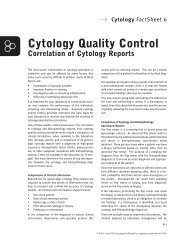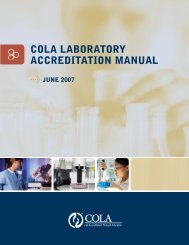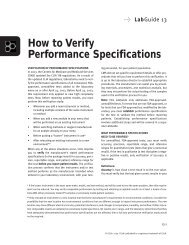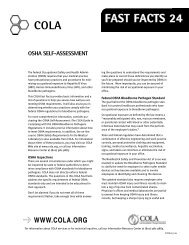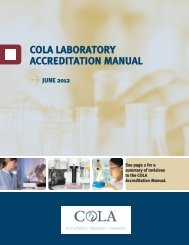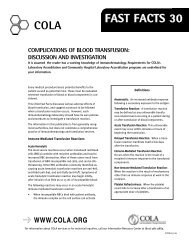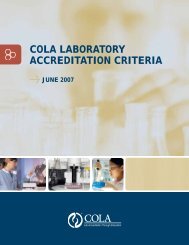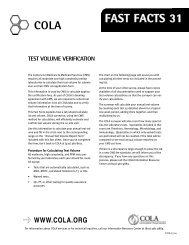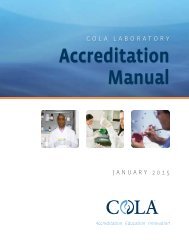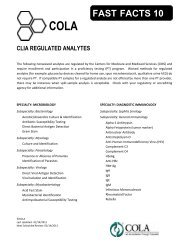#06-5558 Accrd Manual V7 - COLA
#06-5558 Accrd Manual V7 - COLA
#06-5558 Accrd Manual V7 - COLA
- No tags were found...
Create successful ePaper yourself
Turn your PDF publications into a flip-book with our unique Google optimized e-Paper software.
CRITERIA FOR QUALITY LABORATORY PERFORMANCEAny changes made by the laboratory in relation to the above parameters, results in the test being reclassifiedas high complexity. When this occurs, the laboratory must comply with personnel, PT, establishment ofperformance specifications, maintenance, calibration, QC and QA criteria.Laboratories may elect to use reagents other than those of the test system manufacturer. This does not constitutea modification of the test system; however it does require verification of performance specifications.QC 11 RIf calibrators and controls are not available for a particular test, are these tests performed according to establishedmethods and are alternative mechanisms used to monitor test performance and detect potential errors?For tests for which there are no calibrators or control materials available, the laboratory must determine whatprocesses or mechanisms can be used to detect errors that may occur in the complete testing process.Testing procedures should be performed in accordance with standard methodologies whose reliability issupported in literature references. In addition, the laboratory will employ alternative mechanisms such astesting in duplicate, internal or external split samples, comparison of results to other methodologies, correlationof related test results, or other means to detect potential errors. Document all activities performed thatare used as alternatives to traditional calibrators and controls.QC 12 RAre controls run in the same manner as patient specimens and rotated among all operators who perform thetest?Operator variance can be a significant source of error related to some test methods. For this reason, it isimportant to make sure that all individuals involved in performing patient testing are involved in performanceof quality control as well. Control samples should be handled and tested in the same fashion as apatient to verify that the entire test system is working properly. This process can be used as part of the laboratory’smethod of verifying competency of employees to perform testing.QC 13 RWhen QC or calibration material is used to establish a cut off value for determining positive or negative reactivityin patient samples, is the test controlled using materials of a different lot number than those used to establishthe cut off value?It is not acceptable to use the same material (lot number) to standardize or calibrate a test system and determineongoing test accuracy and precision. If there was a problem with the material used to standardize thesystem, you would not be able to obtain accurate results on patient samples; however you would be unableto detect this through the performance of QC. Essentially a bias would be set in your instrument causingresults to be consistently high or low. By using a material of a different lot number you are likely to get somethingwith a different value and different acceptable range. This will allow you to challenge the system andensure the results obtained are within acceptable limits.Necessity may require that the same type of material be used as both calibrator and QC for a given test system.When this occurs, the materials used cannot be of the same lot number.QC 14 RDo you run controls, before resuming patient testing, when there is a complete change of reagents, major preventativemaintenance is performed or any critical part is replaced that may influence test performance?If you have a complete change of reagents, major preventative maintenance is performed or a critical part isreplaced, control materials must be run to verify test performance before patient testing may resume. Referto your Quality Control program for number and type of controls required for the test system involved.QC 15 EIf you perform quantitative tests, are two different control concentrations performed each day of patient testing?30. . . . . . . . . . . . . . . . . . . . . . . . . . . . . . . . . . . . . . . . . . . . . . . . . . . . . . . . . . . . . . . . . . . . . . . . . . . . . . . . . . . . . . . . . . . . . . . . . . . . . . . . . . . . . . . . . . . . . . . . .FOR MORE INFORMATION CONTACT <strong>COLA</strong> PHONE 800.981.9883 | FAX 410.381.8611 | ON-LINE www.cola.org




